Mathematical Modeling and Forecasting of the Demographic Future of Russia: Seven Scenarios
Almanac: Globalistics and globalization studiesGlobal Transformations and Global Future.
Russia is currently experiencing a financial crisis, due to international sanctions coupled with a decline in oil prices. The length and consequences of this period of turmoil are unpredictable, but it will surely have a visible negative impact on crucial socio-demographic indicators. Recent demographic improvements have become one of the most important indicators of the overall success of domestic policy for Vladimir Putin. In the next few years, however, Russia risks facing a repetition of the 1990s' demographic problems once again – with a new wave of mortality increases and a new wave of fertility decline. Pressing economic issues are currently receiving much more attention from the Government; yet an effective anti-crisis strategy also requires paying attention to the seemingly ‛long-term’ demographic problems. Several threats to recent demographic gains have appeared with the crisis. As inflation is rising, more of Russia's population is falling into poverty – and risks of impoverishment have traditionally been the highest for families with many children. As the resources available for families shrink, the recent upturn in fertility rates for second and third children may be reversed. When combined with the rapidly declining numbers of women in active reproductive ages (20–29 years) Russia is almost certain to experience a precipitous decline in fertility. In addition, a dramatic increase in the availability of alcohol is looming, reminiscent of the late 1990s. In 1998 Russia experienced a very serious financial crisis accompanied by a jump in inflation (by 84 %) – however, the excise duty on spirits was increased only much more modestly, by 20 %. As a result, during a single year the relative value of excise duty fell by one-third, leading to dramatic cheapening of vodka and other spirits. Throughout the early 2000s this fall stayed uncompensated for, and the increases in vodka excise taxes frequently lagged behind the inflation rate. This caused an enormous increase in mortality in 1998–2005, when Russia ‛additionally’ lost about two million lives. Today the recurrence of a mortality jump due to various initiatives on liberalizing the alcohol market is, unfortunately, a highly probable scenario. The Government has cancelled an earlier-planned increase in the spirits excise tax, which – given the high and rising rate of inflation – actually means their remarkable decline. The minimum price of vodka has been significantly reduced since February 1, 2015. Beer is supposed to return to sidewalk kiosks, the bans on alcohol advertising in mass media and on alcohol sales overnight are to be virtually lifted, etc. As a result, Russia may face a new round of population decline after all the recent claims of demographic victories. Even more sadly, this decline will probably be written off as the consequences of the economic difficulties, while in reality a new wave of depopulation could be averted – or, at least, substantially mitigated – by carefully designed and well-targeted social policy interventions (many of which are purely legislative and would not put any additional strain upon the budget). A new series of calculations performed by a team of researchers from the Russian Presidential Academy of National Economy and Public Administration (RANEPA), the National Research University Higher School of Economics, the Russian Academy of Sciences, and the Moscow State University demonstrates that ‛alcohol liberalization’ coupled with the absence of a new set of effective family policies may provoke a new demographic collapse with catastrophic consequences. In order to avert this disastrous scenario, appropriate measures must be taken immediately.
Keywords: demography, Russia, mathematical modeling, demographic forecasts, mortality, fertility, demographic policy.
The results presented below are based on a new series of forecast estimates made in early 2015 on the basis of the most recent data on mortality and fertility, applying the same method that was used for mathematical modeling of scenarios in the main text of our Demographic Report (Arkhangelsky et al. 2015; see also Korotayev et al. 2010; Koro-tayev et al. 2011; Korotayev and Bogevolnov 2012; Sadovnichy et al. 2014; Arkhangelsky et al. 2014; Korotayev, Zinkina, and Bogevolnov 2014).
Fig. 1 presents our population projections for Russia up to 2050 based on the inertial forecast scenario – i.e., with fertility and mortality rates held constant at their 2012 values, and with stable migration inflow at 300 thousand annually (the average rate of immigration in Russia according to the results of the National Population Census 2010). If the current rates of fertility, mortality and migration remain unchanged, Russian population is bound to decrease to 135–136 million by 2040 and to less than 130 million by 2050. At first the population decline will be relatively slow, but it will speed up after 2025, as more women of the 1990s' ‘demographic collapse’ generation enter childbearing ages (Fig. 1).
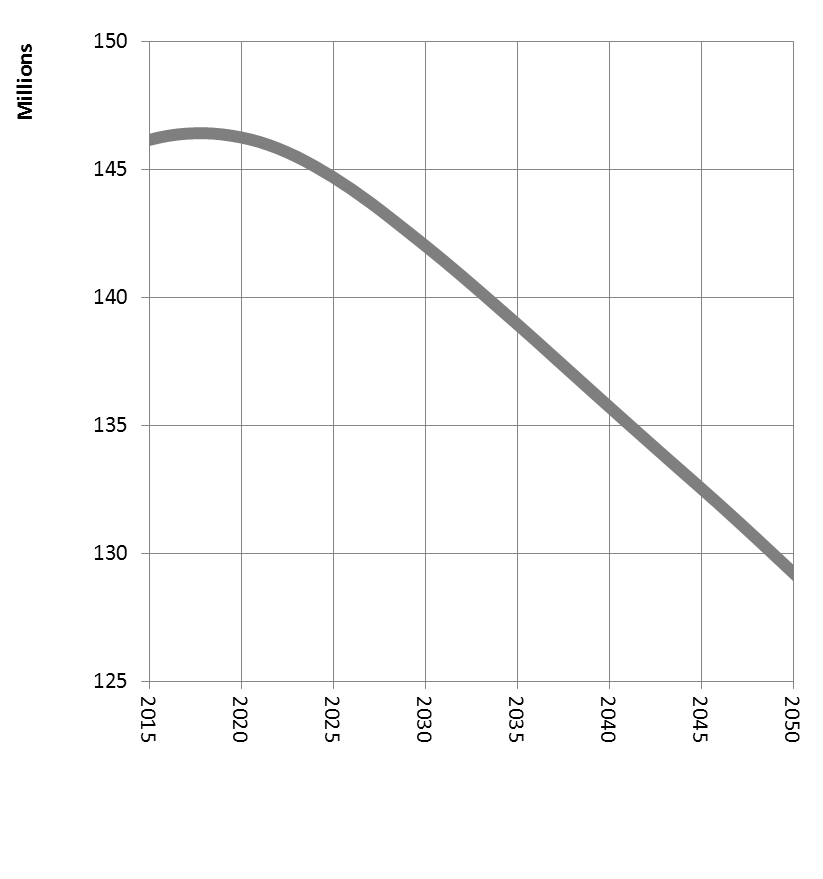
Fig. 1. Population projection for Russia up to 2050 based on the inertial forecast scenario, millions
The inertial scenario looks even grimmer when extrapolated up to 2100 (Fig. 2).
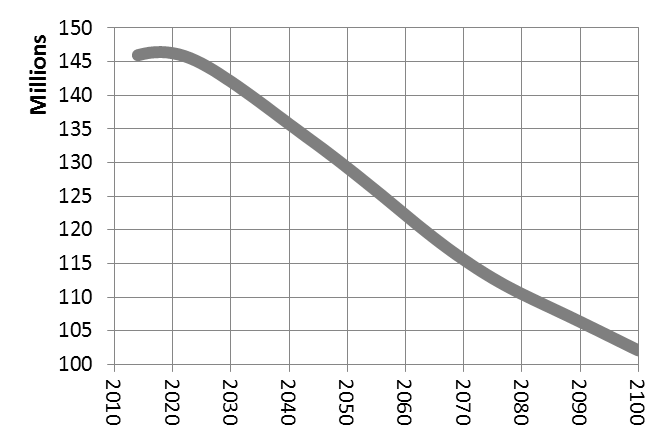
Fig. 2. Population projection for Russia up to 2100 based on the inertial forecast scenario, millions
However, the picture is still not that bad compared to our first inertial forecast scenario, which we calculated in 2009 on the basis of mortality and fertility rates of mid-2000s (see, e.g., Korotayev et al. 2010; Korotayev, Khaltourina, and Bogevolnov 2012). Indeed, according to that inertial forecast Russia's population was to plunge to 111.2 million by 2040 and to 99.5 million by 2050 (Fig. 3).
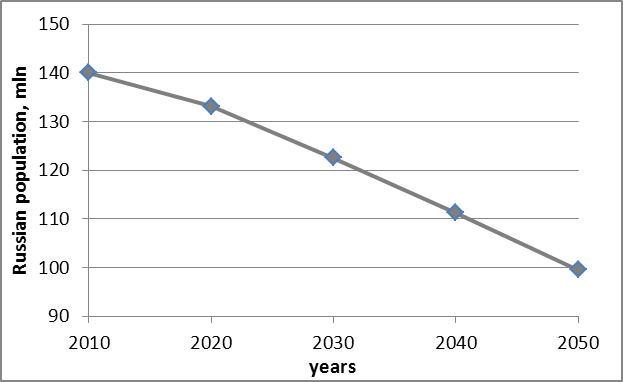
Fig. 3. Population projection for Russia up to 2050, millions. Based on the inertial forecast scenario with mid-2000s’ fertility and mortality rates
Source: Korotayev et al. 2010: 248, Fig. 6.6.
Thus, the latest inertial forecast projects Russia's population to be 24.5 million larger in 2040 and 29.7 million larger in 2050 as compared to the first inertial forecast scenario. This higher trajectory should partially be attributed to annual net migration being revised from 186 to 300 thousand; however, its role is relatively modest. The main contribution to the difference between the two scenarios is made by very significant progress that Russia made in both fertility increase since 2006, and mortality reduction since 2005.
As mentioned in the main report (Arkhangelsky et al. 2015), in 2007–2012 Russia enjoyed a very impressive TFR increase, from 1.3 to 1.691 children per woman (up by 30 %), which was the fastest growth in Europe and the second fastest in the world. Russia moved up from the 35th to the 12th place in Europe in terms of TFR. In absolute terms, the number of births in 2012 was 1.902 million, exceeding the numbers of 2006 by 422 thousand children (or 28 %). The crude birth rate for the period increased from 10.3 to 13.3 per 1000.
Forthcoming Demographic Catastrophe. ‛Alco-pessimistic Scenario‛
The progress in mortality reduction achieved in our country since 2005 is quite significant. In 2005–2013 mortality went down from 2.304 million (Surinov 2013: Table 2.1) to 1.872 million deaths per year1 (by 432 thousand deaths per year). The reduction of alcohol poisoning-related deaths was particularly considerable: the number of lethal intoxications fell from 36,000 in 2005 to 6,700 in 2014.2
The crude death rate fell from 16.1 per thousand to 13.1 per thousand (by 19 ‰). It was the best performance not only in Europe, but among all the high and middle income countries of the world (World Bank 2015). Mortality reduction was achieved almost exclusively due to an increase in life expectancy in Russia, from 65.5 to 70.5 years (by 5 years) in 2005–2012, which was again the best result among all the countries of Europe, America, and Asia (World Bank 2015). Male life expectancy increased by almost six years (Surinov 2013: Table 2.9). The standardized mortality rate among working-age males decreased from 466.8 to 334.3 (almost by 30 %),3 again the best dynamics among all the high and middle income countries (World Bank 2015).
These impressive results were achieved mainly through a reduction in the number of alcohol-related deaths, which had hugely contributed to mortality in the mid-2000s, before the first set of effective anti-alcohol measures was introduced in 2006.4 Alcohol caused excessive mortality in Russia in a variety of ways, of which fatal alcohol poisonings formed only a small proportion. In the mid-2000s 19 % of all deaths in Russia were caused by cardiovascular diseases (including heart attacks and strokes), 68 % of deaths from liver cirrhosis, 60 % deaths from pancreatitis, and 61 % of deaths from all external causes, including 67 % of murders and 50 % of suicides, were associated with alcohol (Nemtsov 2003a, 2003b, 2009, 2011). A large proportion of deaths from pneumonia and tuberculosis are also alcohol-related (Son, Ten, and Pronina 2004: 41−44) because the alcohol abusers are more likely to contract infectious diseases and less likely to get proper treatment. In 1998–1999 in the city of Izhevsk 62 % of males who died in the ages between 20 and 55 had high blood alcohol content (Shkolnikov and Chervyakov 2000: 191) According to a large study conducted in the city of Barnaul in 1990–2004, 68 % of men and 61 % of women who died at the age of 15–34, as well as 60 % of men and 53 % of women who died at 35–69, had high blood alcohol content (Zaridze et al. 2009: 142–153).
It is noteworthy that the mortality decrease in Russia after 2005 is very similar in its structure to the decline during Gorbachev's anti-alcohol campaign of the 1980s (Khaltourina and Korotayev 2006d, 2008b).
In general, the research demonstrates an extremely close relationship between the production of ethyl alcohol from crops and mortality in Russia. A significant increase in production (and consumption) of alcohol leads to an immediate, significant increase in mortality – and vice versa (Figs 4, 5).
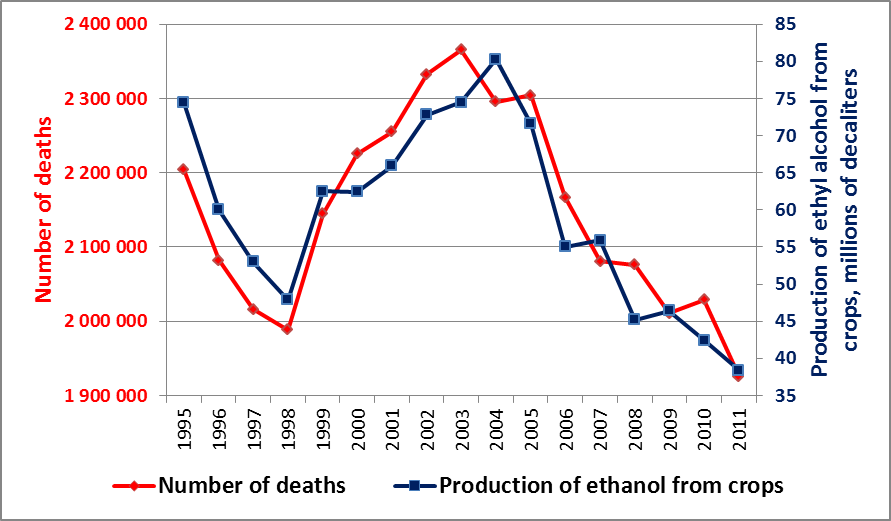
Fig. 4. Production of ethyl alcohol from crops and number of deaths in Russia
Source: URL: http://www.gks.ru.
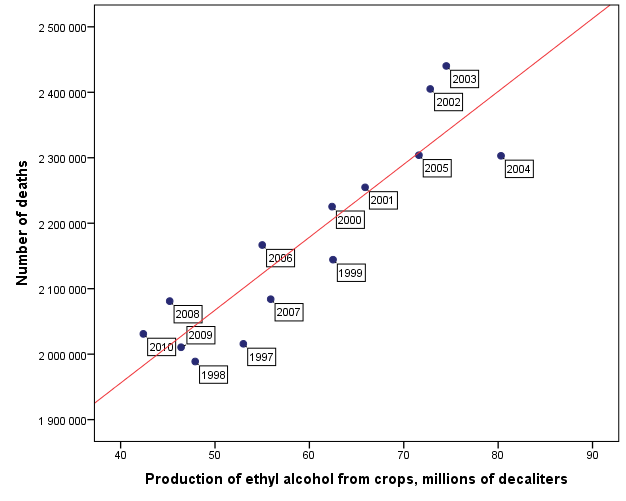
Fig. 5. Correlation between production of ethyl alcohol from crops and the number of deaths in Russia, scatterplot with a fitted regression line
Let us provide some statistical characteristics of the correlation depicted in the last graph. Routinely, the Pearson correlation coefficient (r) is used as a standard measure of the strength of a correlation. In this case its value is greater than 0.9, which means that we are dealing with an extremely strong relationship. It is useful to square 0.9 in order to understand how close the relation is in this case. The square of 0.9 is 0.81 (i.e. 81 %), which is the coefficient of determination (R2). In fact, its value suggests that Russian mortality dynamics of the recent years was predominantly determined by the alcohol factor. Thus, we have a reason to maintain that the record mortality decline observed in Russia after 2005 was more than 80 % determined by a reduction in alcohol consumption, i.e. by the effect of the measures aimed at restricting the availability of alcohol.
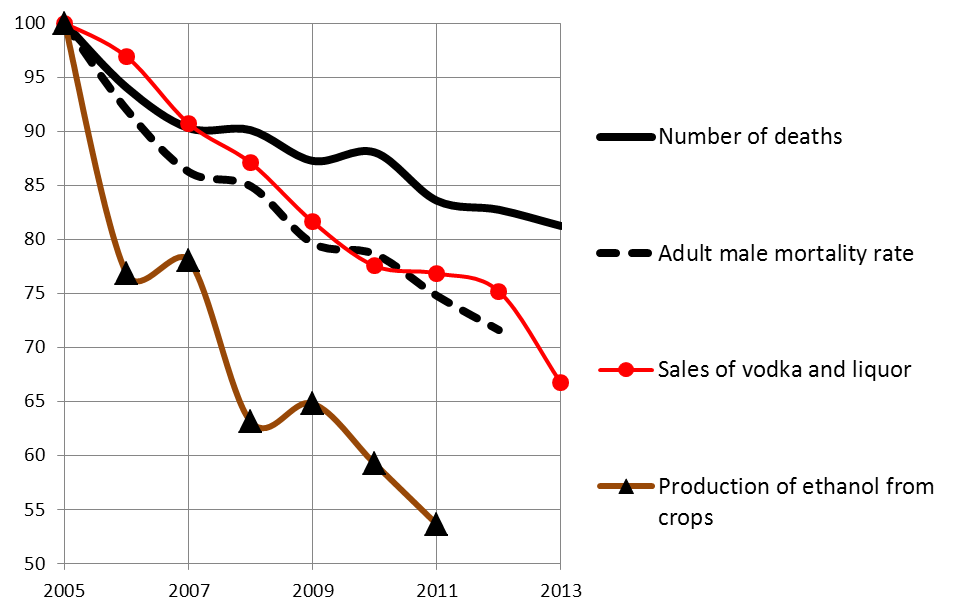
Fig. 6. Relative dynamics of mortality, production of ethyl alcohol from food raw materials, and sales of alcoholic beverages in Russia after 2005 (100 = level of 2005)
Thus, we have strong grounds to believe that Russia's impressive success in reducing mortality after 2005 was achieved mainly due to the state policy of limiting alcohol consumption. These policies were implemented in line with complex evidence-based anti-alcohol measures recommended by the World Health Organization, including higher prices and excise taxes on alcoholic beverages, as well as limitation of the spatial and temporal availability of alcohol. In addition, significant progress was achieved in reducing the consumption of illegal alcohol, marked by the dramatic reduction of alcohol poisonings, including lethal ones.
Yet Russia may lose all these achievements in the near future – if measures are not taken to prevent the looming threats engendered by the initiatives of the alcohol lobby. Hundreds of thousands of ‛additional’ deaths may follow, especially among working-age males, if a return to the days of easy access to alcohol is not averted. Unfortunately, similar reversals have already occurred in recent Russian history: after some growth, fertility would collapse even below its pre-growth level, while significant mortality reduction would be followed by a catastrophic upsurge (Fig. 7).
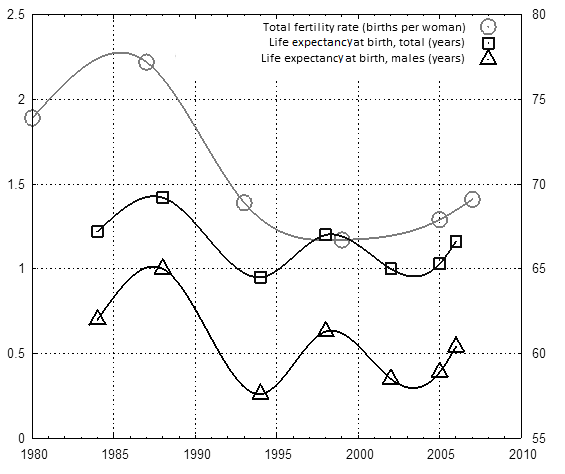
Fig. 7. Dynamics of total fertility rate (births per woman) and life expectancy in Russia. ‘Alcohol collapses’ of the 1990s and early 2000s
Sources: Rosstat 2015; World Bank 2015; UNICEF 2004: 73.
The current situation bears a striking resemblance to the late 1990s. In the midst of an acute financial and economic crisis, the priority of demographic issues declines in favor of solving more immediately pressing financial and economic problems. Meanwhile, measures are adopted that have the effect of dramatically increasing the availability of alcohol. The situation is similar to that of 1998, when Russia experienced a financial crisis accompanied by a jump in inflation (by 84 %) – however, the excise duty on spirits was increased much more modestly, by 20 %. As a result, during a single year the relative value of excise duty fell by one-third. In 2000 the excise tax was increased slightly above the rate of inflation; during the next several years, its annual increase hovered around the inflation rate or slightly below it, so the huge fall of 1998 was left uncompensated for. This fall of the excise tax on vodka was followed by rising income and purchasing power of the population, which caused a huge increase in alcohol consumption (and, hence, mortality) in 1998–2005 leading to the loss of more than a million lives in Russia (see, e.g., Treisman 2008: 9; 2010: 296–297; Nemtsov 2009, 2011; Khaltourina and Korotayev 2006d: 30; 2008b: 28–29). On the contrary, the 2008–2009 economic crisis was not accompanied in Russia by any mortality increase, as it occurred against the background of a strict anti-alcohol policy.
Notably, the acute crisis of the early 1990s led to a catastrophic increase in mortality only in the post-Soviet countries where a sharp increase in alcohol consumption was observed (accompanied by all kinds of the negative social phenomena, such as homicide, suicide, abandoned children, etc.) while in the countries where alcohol consumption remained flat mortality did not increase (as well as the number of murders, suicides, abandoned children, etc.) (Dyomin, Korotayev, and Khaltourina 2009). The current financial and economic crisis is occurring at a time when a set of measures aimed to increase the availability of alcohol has been planned or already taken, so hundreds of thousands of lives are now under a very serious threat. These measures include:
1. Freezing and actual reduction in excise taxes on alcoholic beverages. According to a recently passed law on changes in excise rates,5 actual vodka prices are to be lowered in the next two years – instead of a formerly planned increase. According to the previous version of the Tax Code, excise taxes were to be increased from 500 to 600 roubles per liter of anhydrous ethanol. The increase was to come in force on January 1, 2015. However, a law passed in November 2014 annulled this planned increase and set the excise tax to continue at the previous level. With the rocketing inflation this means a substantial reduction in the actual excise tax.
We should note here that the increase in excise duties on spirits in previous years led to a significant reduction in mortality, on the one hand, and to a simultaneous increase in budget revenues, on the other (see Fig. 8).
The prospects for raising excise taxes on alcohol are further threatened by a draft ‘Agreement on the Principles of tax policy in the field of excise duties on alcohol and tobacco products of the Eurasian Economic Union’. This draft was designed to slow down the increase of excise taxes on tobacco products, but it also has already led to a decrease in excise taxes on alcoholic beverages in Russia.
2. Reduction of the minimum vodka price. On December 29, 2014, the Federal Service for Alcohol Market Regulation set the new minimum retail price (MRP) on strong alcohol (more than 28 % alcohol content) to come in force on February 1, 2015. For the first time in its whole history, MRP was decreased, not increased. The price for a 0.5-liter bottle of 40 % vodka dropped from 220 rubles to 185 rubles (thus getting 16 % cheaper).
3. Russia's capacity to implement independent anti-alcohol policy is being undermined. This threat arises from the draft agreement ‘On regulation of the alcohol market in the framework of the Eurasian Economic Union’ which implies an actual loss of Russia's sovereignty in the issues related to alcohol policy regulation, which will lead to the ‘harmonization’ of liquor prices with Belarus and Kazakhstan (where they are much lower) and, hence, to their further significant reduction, and, consequently, to the further growth of alcohol availability and mortality in Russia.
4. Alcohol ‘liberalization’ in Russian regions. Regional authorities now frequently try to sell alcohol for the longest possible hours under the pretext of combatting illegal sales. For example, last December, the Moscow Region Duma passed an amendment to the law limiting the hours of retail alcohol sales, expanding them to 08.00 – 23.00 from the previous 11.00 to 21.00.
5. Lifting spatial restrictions on alcohol sales. The Federal Service for Alcohol Market Regulation has put forward a law project which permits the sale of alcohol in some educational, medical and cultural institutions. The bill is already undergoing the process of inter-ministerial coordination in the Government.
6. Lifting the ban on remote sales of alcoholic beverages. The Government is discussing lifting the ban on remote sales of alcohol, which will dramatically increase its spatial availability and may lead to mass violations in terms of alcohol sales to minors, as well as illegal alcohol sales in general.
|
Excise duty on spirits, rubles per liter of ethanol |
Budget revenues from excise taxes on spirits, billions of rubles |
|
|
|
|
Deaths from all causes per 1,000 |
Deaths from alcohol poisoning, per 100,000 |
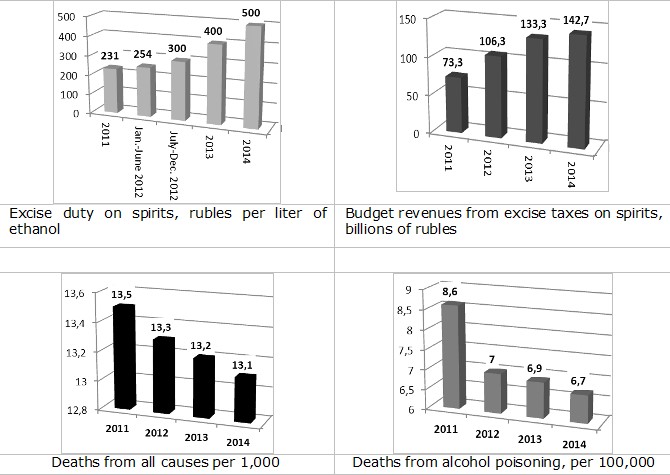
Fig. 8. Dynamics of excise tax on spirits, budget revenues and mortality in 2011–2014
7. Lifting the ban on selling beer in kiosks. The Federal Antimonopoly Service (FAS) has proposed to lift the ban on selling beer in street stalls. The Ministry of Industry and Trade has created a working group to consider this proposal. Meanwhile, the prohibition of street beer sales played a key role in the recent reduction of alcohol consumption by Russian teenagers. The implementation of the FAS initiatives will lead to a new wave of alcohol availability to Russian youth.
8. Legalization of alcohol advertising on television. The State Duma of the Russian Federation has passed laws allowing beer advertising on TV (including the sport channels) and advertising of wine after 23.00, despite the fact that alcohol advertising is one of the most effective ways to accustom youths and adolescents to alcohol consumption.
Projected Effects of State Alcohol Policy Relaxation
The calculations carried out by an expert group of the Russian Presidential Academy of National Economy and Public Administration (RANEPA), the National Research University Higher School of Economics (HSE), Russian Academy of Sciences, and Moscow State University have shown that the forthcoming full-scale relaxation of the state anti-alcohol policy may lead to a total of 5.5 million additional deaths by 2030 (see Fig. 9 and Table 1).
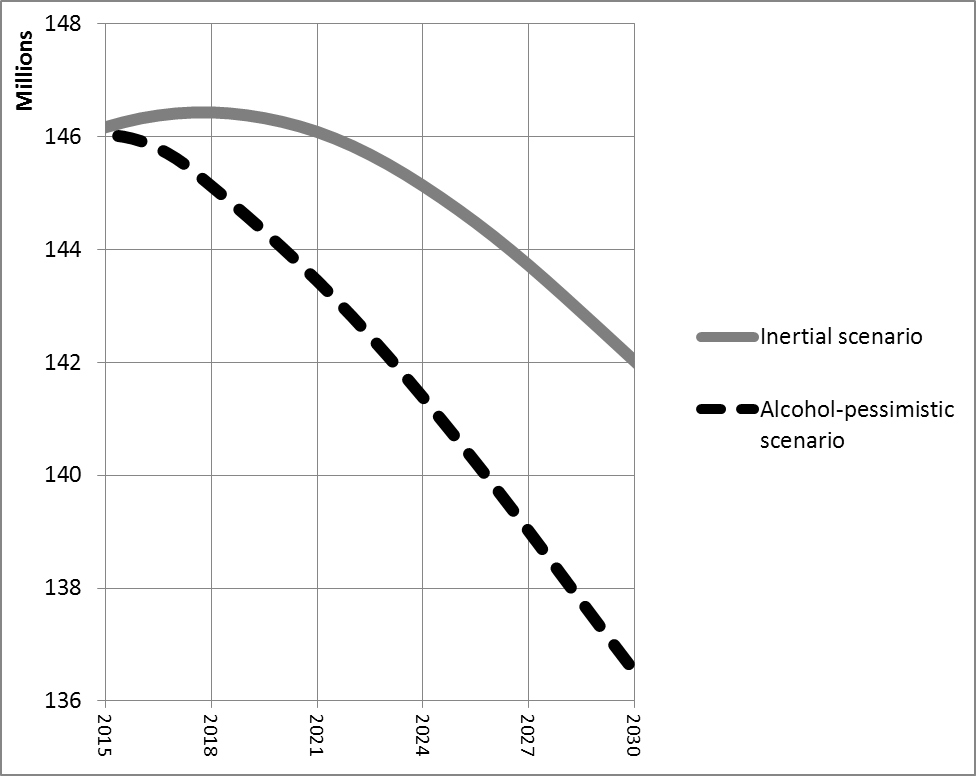
Fig. 9. Population projections for Russia under the ‘alcohol-pessimistic’ and inertial forecast scenarios, millions, 2015–2030
Table 1. Population projections for Russia under the ‘alcohol-pessi-mistic’ and inertial forecast scenarios, millions, 2015–2030
|
Year |
Projected population of Russia, millions |
‘Alcohol-pessimistic’ scenario ‘price’ in the number of ‘additional’ deaths as compared to the inertial scenario | |
|
Inertial scenario |
Alcohol-pessimistic scenario | ||
|
2020 |
146,3 |
144,0 |
2,3 |
|
2030 |
142,0 |
136,5 |
5,5 |
The number of working-age males will be particularly affected (Fig. 10).
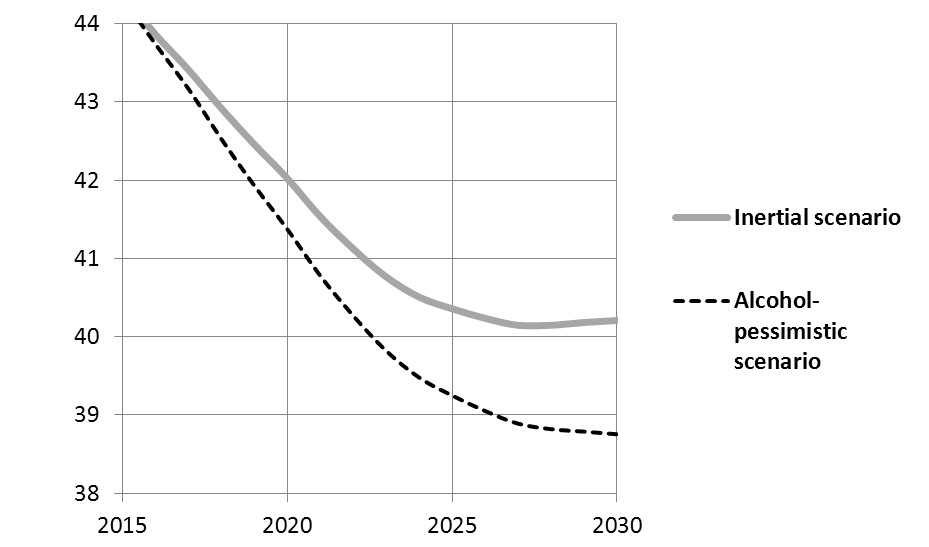
Fig. 10. Population projections for working-age males in Russia under the ‘alcohol-pessimistic’ and inertial forecast scenarios, millions, 2015–2030
Thus, the changes in legislation proposed by the alcohol lobby may lead to a significant increase in alcohol consumption and therefore to an increase in alcohol-related mortality, morbidity and social problems. Such consequences are extremely likely to seriously undermine Russian progress to goals set forth in the Presidential Decree № 606 of May 7, 2012 ‛On measures for implementation of demographic policy of the Russian Federation’, particularly as regards reaching the target value of 74 years of total life expectancy by 2018. Moreover, their overall demographic consequences for our country may be disastrous; so urgent measures must be taken to avert the upsurge of population loss.
How to Prevent the Demographic Catastrophe
Even if the pending ‘pro-alcohol’ legislative initiatives are simply blocked, life expectancy will not go beyond the current value of 71 years. A simple preservation of the state anti-alcohol policy in itself will not suffice to increase the Russian life expectancies up to 74. For this, we need additional limitations on the availability of alcohol, both in time, in space, and economically. Price availability of alcohol must be seriously curbed. It would no longer suffice to return to the initially planned (starting from January 1, 2015) increase of the excise tax on spirits from 500 to 600 rubles6 (which was derailed by the alcohol lobby). Due to the dramatic inflation jump, the new law should raise the excises not to 600 rubles but at least up to 650 rubles. The ban on the sales of alcohol between 11 p.m. and 8 a.m. should be extended to a bigger time interval between 8 p.m. and 11 a.m. Banning morning alcohol sales has proved highly effective in Nordic countries as this blocks the opportunity to have a morning drink after a hangover (which may often lead to prolonged drinking bouts).
Sales of alcoholic beverages stronger than 15 % are advised to be prohibited in department stores unless separated from other departments with a special entrance. This cuts down on spontaneous purchases, i.e. ‛once entering a shop to buy some bread, one is provoked to purchase some alcohol by seeing it exposed on the shelves’ (Dyomin, Korotayev and Khaltourina 2009: 47).
We should not exclude the possibility of returning to the state monopoly on retail sales of the strong drinks in Russia. This measure has proven to be a very effective tool for reducing alcohol problems and mortality in Sweden, Iceland, Norway, Finland, Canada, etc. In the USA 19 states also have some form of monopoly on the sale of liquor. In these states alcohol consumption is 14.5 % lower for those aged 14–18, and the frequency of abuse of alcohol by this age group (intake of more than 70 g of ethanol at one time) is 16.7 % lower than in the states without such a monopoly. There is a 9.3 % lower alcohol-impaired driving death rate under age 21 in the monopoly states versus the non-monopoly states (Holder 2007). In the Scandinavian countries such a monopoly allows the sale of alcoholic beverages (usually stronger than 4.7–5 %) only in state stores (except for bar service). In addition such a monopoly helps to fill the state budget. The monopoly countries enjoy higher revenue from the sale of alcoholic beverages than the non-monopoly countries with the same level of economic development (Rehm et al. 2001). A major advantage of the state monopoly on the retail sale of alcoholic beverages is that it minimizes the private interest in maximizing alcohol sales, which in this area often confronts the public interest. An employee of a store belonging to the state has no interest in selling alcohol to minors because his salary does not depend on the store's revenue – while the owner of a private shop may capitalize on it (Ugland 2000).
International experience shows that to maximize health and longevity, national alcohol policy should be regulated by the social branch of the Government, as is done in the Scandinavian countries, not by the economic branch. The Ministry of Health, the Federal Service for Supervision of Consumer Rights Protection and Human Well-Being and the Federal Service for Alcohol Market Regulation must take control over this policy to fight the alcohol black market.
The Worst-Case (Pessimistic) Scenario
However, it is obvious that the alcohol-pessimistic inertial scenario is by no means the worst possible case. The worst (‘pessimistic’, ‘pessimal’) demographic scenario will be realized only if a radical surge in mortality coincides with an avalanche-like collapse in fertility. Unfortunately, this scenario is not entirely improbable. First, a certain decline in crude birth rates is virtually inevitable in the forthcoming decade due to the reduction in the number of women aged 20–29, who mother more than 60 % of all births in Russia. This is given by Russia's age structure and the very small cohorts born in the 1990s who are now entering their prime child-bearing years. Second, most respondents explain their reluctance to have more children by referring to material difficulties and feeling uncertain about future (Rosstat 2013). Rising insecurity almost inevitably leads to a decrease in birth rates – this is particularly true for financial and economic crises (Fig. 11).
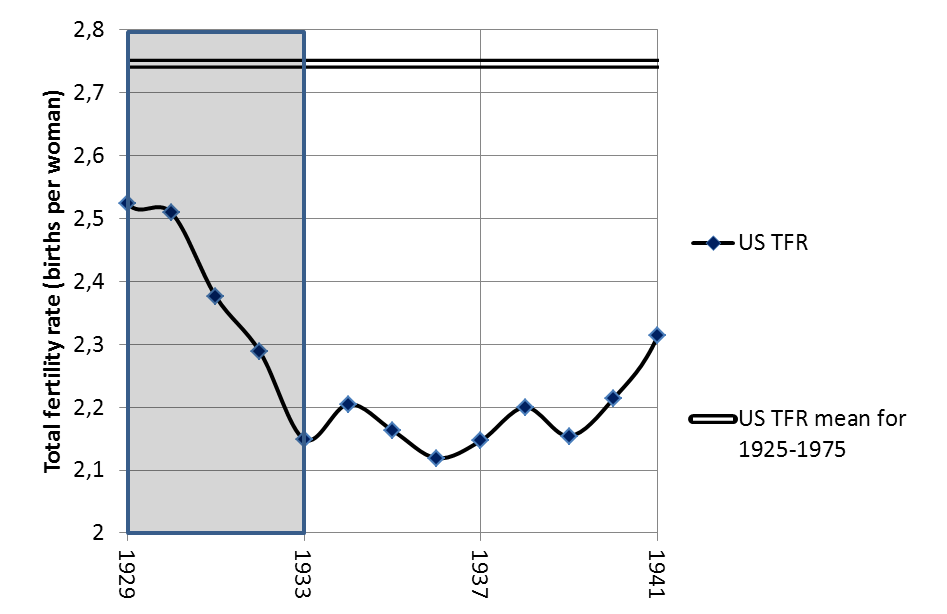
Fig. 11. Birth rate slump in the United States during the Great Depression (1929–1933)
Source: Campbell et al. 1966: 4; World Bank 2015.
The stimulating role of the maternal capital policy in boosting fertility is bound to decrease, as 97 per cent of the families used to spend its benefits for improving their living conditions, which will become much harder during the current economic crisis. Strong measures are required to prevent a severe birthrate collapse. The financial and economic crisis of 2008–2009 in Russia did not lead to the collapse in fertility rates due to strong and effective family policy measures launched before and during the crisis. The crises of the late 1980s – early 1990s and the late 1990s were accompanied by a decline in fertility because no such measures were taken. For example, on the eve of 1998 crisis fertility was already very low (1.24 children per woman) but during the crisis it dropped to an unprecedented level of 1.17 children per woman. In the late 1980s, as the starting point of fertility was already fairly high (see, e.g., Korotayev et al. 2010; Korotayev, Khaltourina and Bogevolnov 2012: 96–219), the decline in response to the economic distress of the early 1990s was much steeper. In fact, it collapsed so deep that the consequences of the ‘demographic hole of the 1990s’ are still present (see above the main text of the report).
Most likely some decline in the birth rate of Russia in 2015 is inevitable. The positive trend of recent years could be kept only if the proper measures had been introduced in 2014. For example, there were about an additional 100 thousand newborns in 2012 due to the policies of free distribution of lands and allowances for the third child. If the maternal capital program is to be cancelled after 2016 (followed by cuts in other family support programs), this will result in catastrophic demographic consequences.
The ‘most pessimistic’ scenario presents the population projections in a situation when a victory of the alcohol and tobacco lobby is combined with cuts in the family support programs, leading to a retreat to the worse values of mortality and fertility of the mid-2000s.
The results of the calculation of this scenario are as follows (Fig. 12).
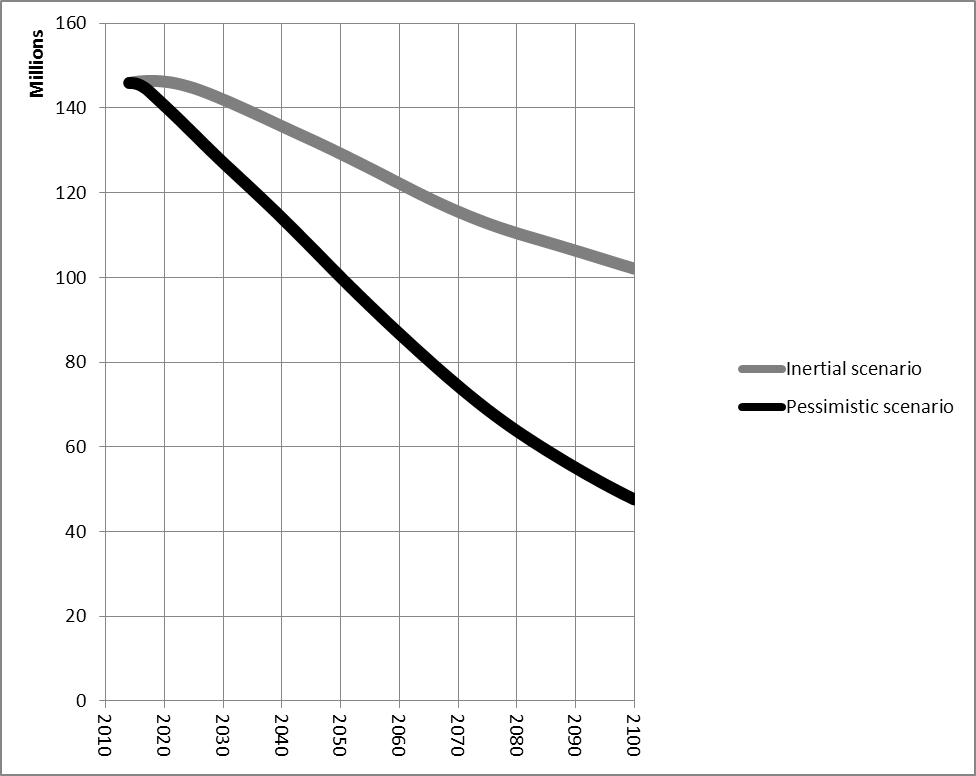
Fig. 12. Pessimistic and inertial scenarios of the Russian population dynamics for the period till 2100, millions
Thus, if no strategic priority is given to socio-demographic policy, this result may well lead to the end of geopolitical career of Russia by the end of the century.
Possible Demographic Effect of a Full-Scale Family Policy Consuming Not Less than 3 Per Cent of GDP
It is also possible to model the effect of developing a high-priority demographic policy structure that would aim to reach Western European levels of fertility, closer to the replacement rate of two children per woman. This effect was modeled by a smooth (for 10 years) transition of age-specific fertility rates by 2020 in Russia to the level of France in 2012 (corresponding to TFR = 2.0), while preserving Russia's age-specific mortality at the level of 2012.
According to international studies and best practice, the most effective measures to improve fertility include a combination of allowances, tax benefits, programs and legislation supporting parents in combining parenting and employment, including access to kindergartens, nurseries, nannies and flexible schedules for employees with family responsibilities. During a crisis the measures stimulating economic activity of parents may be more effective in boosting fertility than cash transfers. An effective system of care for children is also one of the most effective policy measures to support the birth rate. Of all the types of expenditures in OECD the costs of services for child care (namely kindergartens, nursery nurses and payment) correlate the best with the level of fertility. It is extremely important for the child care system to develop a network of services for the care of the youngest children (under 3 years). Comparative analysis shows that all of the most demographically successful countries in Europe have built a wide covering system of free or subsidized services for the care of children under 3 years old. There are not enough kindergartens in Russia and the youngest children are not a priority group. Only 58 per cent of Russian children under six had access to preschool education facilities in contrast with 90 per cent in France. A set of housing support measures such as subsidized rental housing for young and large families, development of housing and savings cooperatives, as well as substantial subsidies of mortgage rates for families with children may also improve fertility.
The corresponding ‘high demographic priority’ forecast of population of the Russian Federation (as compared to the inertial scenario) is as follows (Fig. 13).
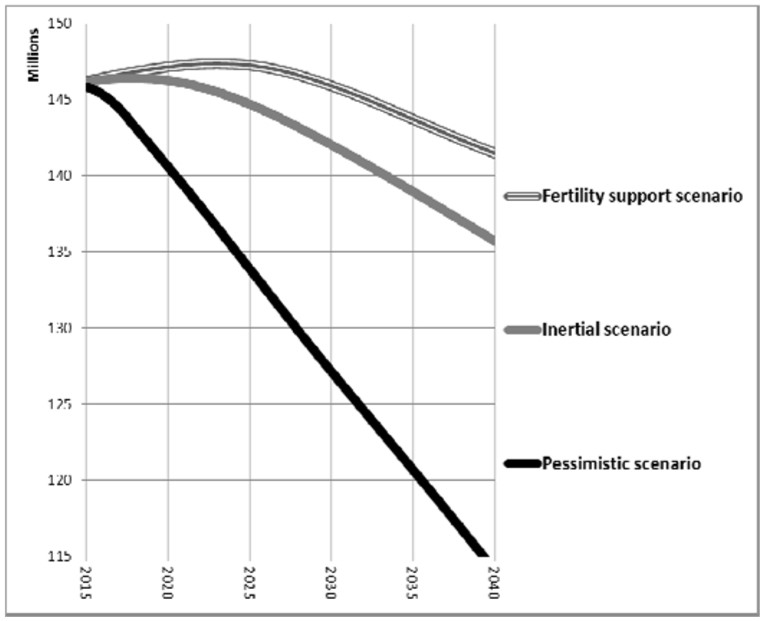
Fig. 13. Scenario of full-scale measures of fertility support in comparison with the inertial and pessimistic scenarios for the Russian population dynamics, millions, 2015–2050
As we can see, measures to support the birth rates can give a significant long-term demographic effect (especially if we can prevent the growth of mortality in our country), but these measures alone are insufficient to prevent Russian depopulation, due to Russia's persistent mortality rates.
Potential Effect of the Anti-Alcohol Policy
If a full-scale alcohol control policy is consistently implemented in Russia, our calculations demonstrate that such a deliberate anti-alcohol policy still has an immense demographic potential and will have a very significant long-term demographic impact (see Fig. 14 and Table 2).
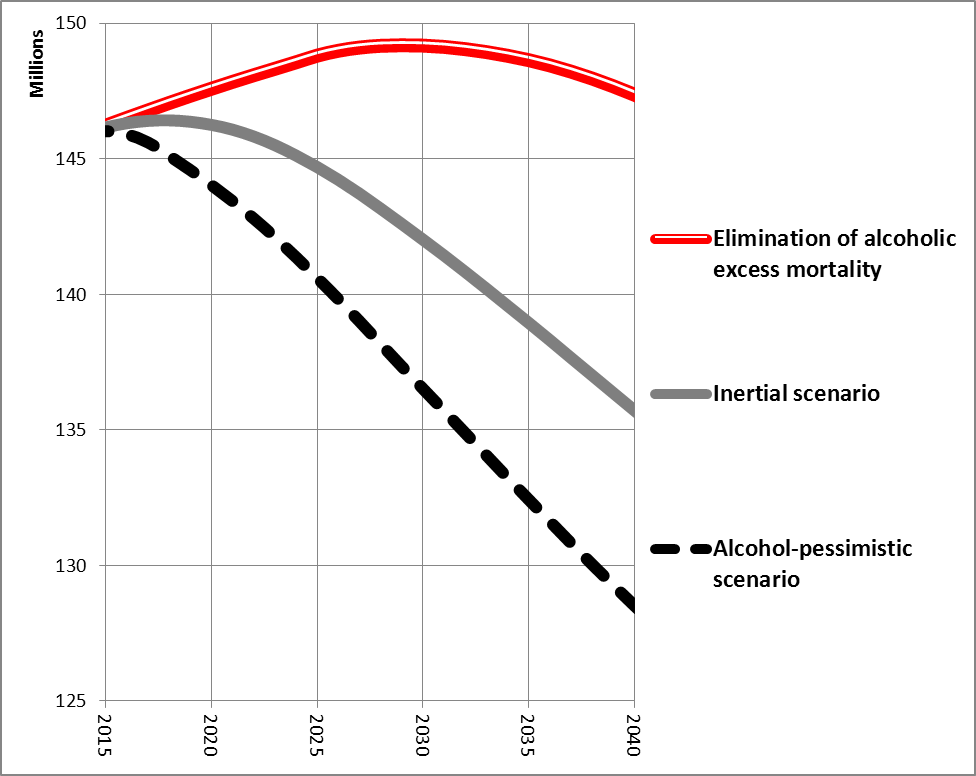
Fig. 14. Scenario of full-scale anti-alcohol policy in comparison with the inertial and alcohol-pessimistic scenarios of the Russian population dynamics, till 2040, millions
Table 2. Population projections for Russia under the ‘alcohol-pessi-mistic’ and ‘full-scale alcohol policy’ scenarios, millions, for 2015–2040 (‘Issue price’ in human lives)
|
Year |
Projected population of Russia, millions |
‘Alcohol-pessimistic’ scenario ‘price’ in the number of ‘additional’ deaths as compared to the full-scale alcoholic policy scenario | |
|
Alcohol-pessimistic scenario (millions) |
Full-scale alcoholic policy scenario (millions) | ||
|
2020 |
147.6 |
144.0 |
3.6 |
|
2030 |
136.5 |
149.2 |
12.7 |
|
2040 |
128.5 |
147.4 |
18.9 |
These estimates demonstrate the enormous demographic potential of standard alcohol control measures recommended by the World Health Organization for the future of our country (Dyomin et al. 2009).
Implementation of these affordable and even profitable measures (such as increasing excise duties on spirits or the introduction of a state monopoly on retail sales of alcohol) may save up to 19 million lives by 2040.7 Thus, in the short and medium term the alcohol control policy may have an even greater demographic impact than the policy of supporting the birth rate (though in a long run the fertility support policy is significantly more effective).
The Forecast Effect of Complete Elimination of Russian Excess Mortality
Total elimination of Russian excess mortality would have an especially significant long-term demographic effect. Such results may be achieved through policies including anti-alcohol and anti-tobacco measures, as well as radical improvement of the Russian health care system by increasing the financial allocation for health care to at least 10 % of GDP.
This effect was modeled by a smooth (for 10 years) transition of the age-specific mortality rates in Russia to reach the corresponding values of Norway in 2009 (this scenario does not imply that by 2020 Russia will overtake Norway; it only starts with the assumption that Russia will be converging to Norway, reaching by 2020 the Norwegian level of 2009, so this scenario is not excessively optimistic).8
As we can see the complete elimination of Russia's excessive mortality may provide a more significant effect in the short and medium term than fertility support. Nonetheless, because of the small birth cohorts of the 1990s, whose effect will be magnified over time if they too give birth to small cohorts the elimination of Russia's high mortality cannot, by itself, prevent an eventual return to population decline. If extreme mortality is eliminated, but fertility is preserved as it was in 2012, the Russian population will keep growing only until the mid-2030s. It would then start shrinking in the late 2030s, and this decline would accelerate thereafter.
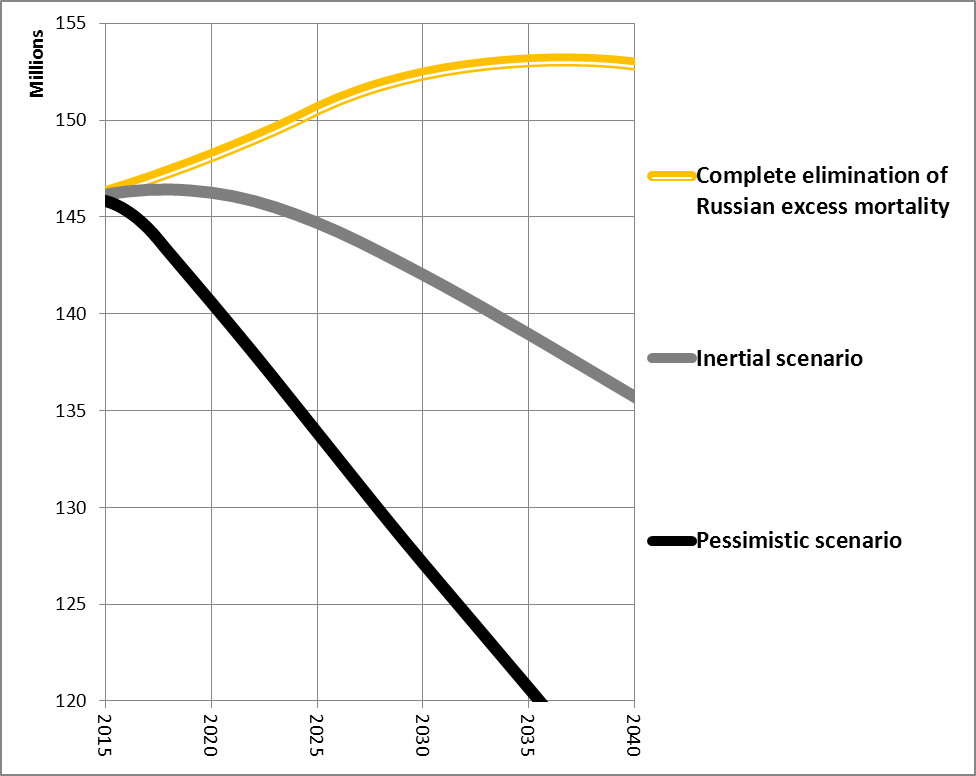
Fig. 15. Scenario of complete elimination of Russian excess mortality in comparison with the inertial and pessimistic scenarios of the Russian population dynamics, till 2040, millions
The Combination of Measures that Can Prevent Depopulation. The ‘Most Optimistic’ Scenario
Only the combination of an effective fertility support system and the elimination of Russia's excessively high mortality (‘the best case scenario’) may fully avert the looming threat of depopulation. It is worth noting that even under the optimum scenario the effects of the demographic hole of the 1990s will be felt in the 2040s as the small generation of the children born to the mothers born in the 1990s will reach their reproductive age. Nevertheless, in the most optimistic scenario future population decline would be averted, and in the future the population of Russia will stabilize at a level slightly higher than today's (Fig. 16).
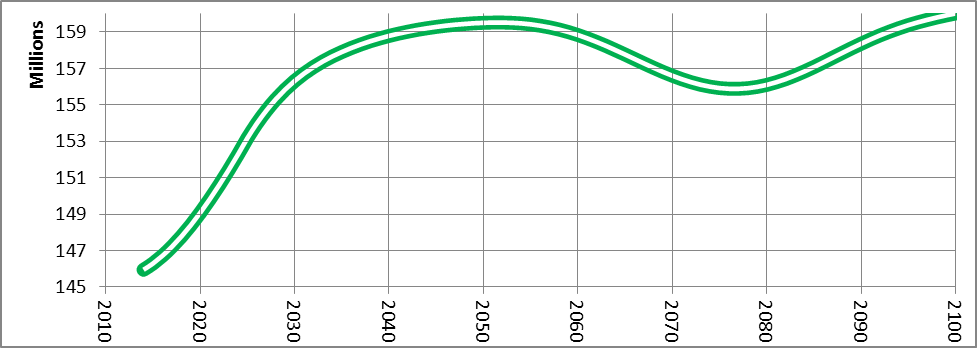
Fig. 16. Optimum demographic scenario of the dynamics of the Russian population (combination of an effective system of fertility support measures and the elimination of the Russian excess mortality), millions, 2015–2100
It is time to compare the optimistic forecast with the other scenarios of Russia's demographic future (Fig. 17).
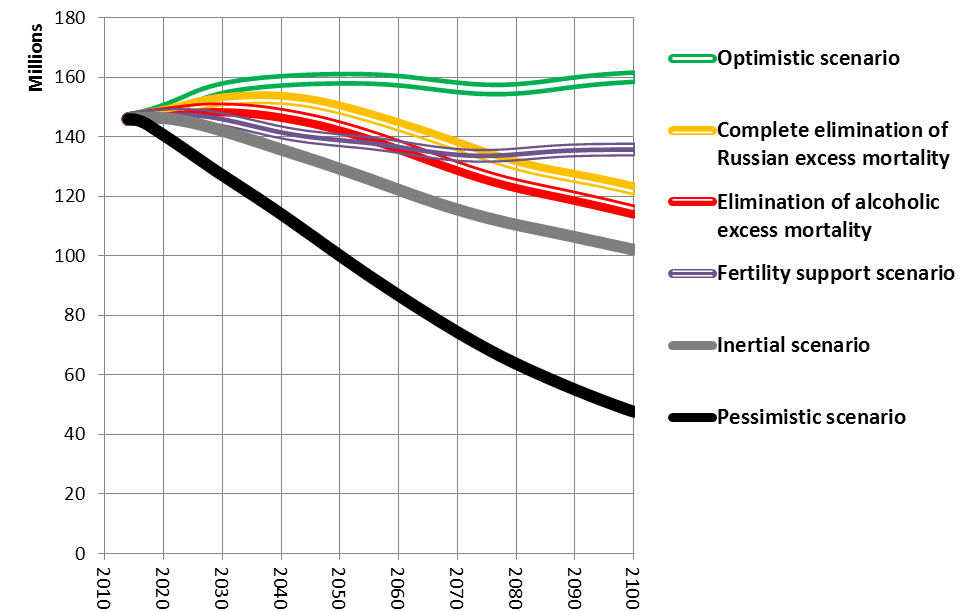
Fig. 17. Forecast scenarios of the demographic future of Russia, projected dynamics of the population of the Russian Federation in 2015–2100, millions
As we can see in Fig. 17, there is a huge gap between the ‘lower’ (‘pessi-mistic’) and the ‘upper’ (‘optimistic’) scenarios. This is a gap of over 100 mil-lion human lives. This estimate gives an idea of the price of decisions made today. The forecast calculations for the period up to 2100 show that the birth support measures have the highest impact on the demographic future in the long run. However, in the short and medium term, the anti-mortality measures are the most effective (in particularly, the measures targeting alcohol-related mortality). As a whole, according to our forecast calculations, the demographic future of Russia can be secured only with both the elimination of excessive mortality and with continued improvement in fertility toward full replacement rates (e.g., fertility 2.0 or higher).
For this to occur, current attitudes must be changed. Today the availability of alcohol is increasing instead of being curbed. At the same time the country is facing a new crisis while no new measures to provide stronger support for fertility support are expected.
A Demographic Maneuver: Additional Revenues from Alcohol and Tobacco Can Stimulate the Reduction in Mortality and the Growth of Fertility
There is a demographic maneuver than can be undertaken to reduce mortality and stimulate fertility, and at the same time reduce smoking and alcohol consumption, save 300–400 thousand lives a year and ensure the growth of budget revenues. An increase in excise duties, by itself an unpopular measure, should be linked with measures to support families with children. It is recommended to create a Trust Fund, funded by higher excise taxes on alcohol and tobacco, to support family and health.
The Fund should provide funding for the following areas:
-
to secure the opportunity for families to purchase housing with mortgage loans at 5 % interest rate after the 2nd birth (through the already existing Agency for Housing Mortgage Lending);
-
to secure the opportunity for families to purchase housing with mortgage loans at zero interest rate after the 3rd birth (through the Agency for Housing Mortgage Lending);
-
to ensure 100 % availability of pre-school education and childcare for children from 1 to 7;
-
co-financing of regional programs for prevention and reduction of cardiovascular disease in areas with a high mortality rate in their working age population;
-
co-financing of regional programs of housing rent subsidies for families with children;
-
additional social support for families with children in regions with unfavorable demographic situations.
During the economic crisis the Foundation of Family and Health Support could ensure the implementation of additional measures of supportive demographic policy, and contribute to ensuring sustainable growth of population after the crisis.
There are no ‘magic bullets’ to easily solve Russia's demographic problems, which are the result of decades of economic ups and downs and shifts in policy. However, establishing a Trust Fund for family support and national health, increasing taxes on alcohol and tobacco, and using those funds for pro-fertility programs, is a policy that would achieve several goals at once without imposing additional cost on the current budget. It would also focus attention on long-term planning to resolve the problems that threaten Russia's demographic future.
As the earlier sections of the present article have shown, Russia enjoyed great success with its policies to promote fertility and reduce mortality in the last seven years. However, it would be a foolish and costly mistake to believe those successes had ‘solved’ Russia's long-term demographic problems. Quite the reverse; they were only a promising ‘down payment’ on the policies needed to truly put Russia's long-term demographic future on a secure course. Without continuing and expanding the present policies, that future security will dissolve. Worse yet, the policies currently being considered to boost access to alcohol will almost certainly reverse recent progress and set Russia back upon a path of inevitable demographic decay.
Appendix. Calculation Methodology
We have based our population projections on the standard methodology of building demographic forecasts (see, e.g., Andreev and Vishnevsky 2008: 265–288; Belotelov et al. 2001: 43–51; Pavlovsky et al. 2005). The calculations were made on an annual basis. At step one, an equation (1) is used to calculate the number of the dead based on annual mortality ratios and migration inflow. The age structure was modified in accordance with the calculation. At step two (equations (2F) and (2M)), the number of infants is calculated based on childbirths and infant survival rate and migrations (migrants with infants). Based on the current age structure, the number of women is calculated for each 5-year group. The number of babies is calculated for each group using age fertility ratios and then summed up. We assumed that 100 girls are born per 105 boys. Then the age structure is moved ‘down’ to the previous year and the number of babies is recorded at the very beginning. The time calculator is increased by one year and then the calculation is repeated (step one and then step two).
Preparation of source data. Source data for birthrates were calculated based on age (5-year groups) fertility ratios and target values (Rosstat 2015) by linear interpolation. A similar procedure (Human Mortality Database)9 was performed for mortality and migration. 10
We took as source data the age and sex structure for 2010 (Rosstat). The calculation started from 2010.
The drawback of the Demographic Concept is that mortality is recorded in relative units. We used age and sex mortality per 1,000 people as a demographic indicator for actual calculations.
Equations used for calculations are as follows:

where
|
t |
– |
time variable (in this case one year); |
|
τ |
– |
lower band of the age group; |
|
uM, F (τ, t)
|
– |
number of persons (hereinafter lower indices mean M – men, F – women) aged from τ to τ + 1 years at the moment of time t; |
|
(τ, t)
|
– |
annual average number of persons (hereinafter lower indices mean M – men, F – women) aged from τ to τ + 1 years at the moment of time t; |
|
b(τ, t) |
– |
age specific birth rates, women, age from τ to τ + 4 (i. е. by 5-year groups) at the moment of time t; |
|
dM, F (τ, t)
|
– |
age specific mortality rate, age from τ to τ + 1 at the moment of time t; |
|
mM, F (τ, t)
|
– |
number of migrants (arrived in the country), this number (generally) may be negative in case of population outflow from the country; |
|
LM0, F0 (t) |
– |
infants survival function at time t. |
Equation (1) describes shift of the age structure by one year (due to mortality and migration), equations (2F) and (2M) describe the ‘source’ (i.e. number of babies).
References
Andreev, E., and Vishnevsky, A. 2008. Demographic Prospects of Russia till 2050. In Vishnevsky A. (ed.), Russia's Population 2006 (pp. 265–288). Moscow: Vysshaya shkola ekonomiki. In Russian (Андреев Е., Вишневский А. Демографическое перспективы России до 2050 г. Население России 2006 / Ред. А. Вишневский, с. 265–288. М.: Высшая школа экономики).
Arkhangelsky, V. N., Bozhevolnov, Yu. V., Goldstone, J., Zvereva, N. V., Zinkina, Yu. V., Korotayev, A. V., Malkov, A. S., Rybalchenko, S. I., Ryazantsev, S. V., Steck, P., Khaltourina, D. A., Shulgin, S. G., and Yuryev, Y. L. 2014. It Will Be Late in 10 Years. Population Policy of the Russian Federation: Challenges and Scenarios. Moscow: Institut nauchno-obschestvennoy ekspertizy – RANKhiGS pri Prezidente RF – Rabochaya gruppa ‘Semeynaya politika i detstvo’ Ekspertnogo soveta pri Pravitelstve RF. In Russian (Архангельский В. Н., Божевольнов Ю. В., Голдстоун Д., Зверева Н. В., Зинькина Ю. В., Коротаев А. В., Малков А. С., Рыбальченко С. И., Рязанцев С. В., Стек Ф., Халтурина Д. А., Шульгин С. Г., Юрьев Е. Л. Через 10 лет будет поздно. Демографическая политика Российской Федерации: вызовы и сценарии. М.: Институт научно-общественной экспертизы – РАНХиГС при Президенте РФ – Рабочая группа ‘Семейная политика и детство’ Экспертного совета при Правительстве РФ).
Arkhangelsky, V., Bogevolnov, Yu., Goldstone, J., Khaltourina, D., Korotayev, A., Malkov, A., Novikov, K., Ryazantsev, S., Rybalchenko, S., Shulgin, S., Steck, P., Yuriev, Y., Zinkina, J., Zvereva, N. 2015. Critical 10 Years. Demographic Policies of the Russian Federation: Successes and Challenges. Moscow: Russian Presidential Academy of National Economy and Public Administration (RANEPA).
Belotelov, N. V. et al. 2001. Ecological, Social and Economic Imitating Model: Human and Informational Aspects. Informatsionnoye obshchestvo 6: 43–51. In Russian (Белотелов Н. В. и др. Эколого-социально-экономическая имитационная модель: гуманитарный и информационный аспекты. Информационное общество 6: 43–51).
Campbell, A. A., Clague, A., Godley, F., and Rosenberg, H. M. 1966. Natality Statistics Analysis. Washington, DC: U.S. Department of Health, Education, and Welfare (National Center for Health Statistics Series 21/8).
Dyomin, A. K., Korotayev, A. V., and Khaltourina, D. A. 2009. Alcohol Abuse in the Russian Federation: Socioeconomic Consequences and Counteraction Measures. Report of the Public Chamber of the Russian Federation. Moscow: Obshchestvennaya Palata Rossiyskoy Federatsii. In Russian (Демин А. К., Коротаев А. В., Халтурина Д. А. Злоупотребление алкоголем в Российской Федерации: социально-экономические последствия и меры противодействия. Доклад общественной палаты Российской Федерации. М.: Общественная Палата РФ).
Holder, H. D. 2007. Alcohol Monopolies and Public Health. Evidence from International Research. Paper presented at the International Seminar on Alcohol Retail Monopolies. Stockholm, 27–29 August.
Khaltourina, D. A., and Korotayev, A. V. 2005. Russian Demographic Crisis: Factors, Models, Counter-crisis Measures. In Malkov S. Yu. (ed.), Mathematical Modeling of Social Dynamics (pp. 117–191). Мoscow: KomKniga/URSS. In Russian (Халтурина Д. А., Коротаев А. В. Российский демографический кризис: факторы, модели, пути решения. Математическое моделирование социальной динамики / Ред. С. Ю. Малков, с. 117–191. М.: KomKniga/URSS.
Khaltourina, D. A., and Korotayev, A. V. 2006a. Alcohol and Narcotics as Factors of Demographic Crisis. Sotsiologicheskiye issledovaniya 7: 104–112. In Russian (Халтурина Д. А., Коротаев А. В. Алкоголь и наркотики как фактор демографического кризиса. Социологические исследования 7: 104–112).
Khaltourina, D. A., and Korotayev, A. V. 2006b. Alcohol and Narcotics as the Major Factors of Demographic Crisis in Russia. Narkologiya 8: 41–57. In Russian (Халтурина Д. А., Коротаев А. В. Алкоголь и наркотики как важнейшие факторы демографического кризиса. Наркология 8: 41–57).
Khaltourina, D. A., and Korotayev, A. V. 2006c. Potential of Alcohol Policy as a Factor of Bringing down the Mortality in Russia. In Vallin J. (ed.), Mortality in Countries of the Former USSR. Fifteen Years after Break-up: Change or Continuity? (pp. 243–259). Kiev: Institute for Demographic and Social Studies.
Khaltourina, D. A., and Korotayev, A. V. 2006d. Russian Cross. Factors, Mechanisms and Pathways of Overcoming Demographic Crisis in Russia. Moscow KomKniga/URSS. In Russian (Халтурина Д. А., Коротаев А. В. Русский крест. Факторы, механизмы и пути преодоления демографического кризиса в России. M.: КомКнига/УРСС).
Khaltourina, D. A., and Korotayev, A. V. 2008a. Alcohol and Narcotics as Factors of the Demographic Crisis. Sociological Research 47(3): 18–31.
Khaltourina, D. A., and Korotayev, A. V. 2008b. Introduction. How to Stop Depopulation of Russia. In Khaltourina D. A., and Korotayev A. V. (ed.), Alcohol Catastrophe. Potential for State Policies to Surmount the Alcohol Mortality in Russia (pp. 5–58). Moscow: Lenand/URSS. In Russian (Халтурина Д. А., Коротаев А. В. Введение. Алкогольная катастрофа: Как остановить вымирание в России. Алкогольная катастрофа. Возможности государственной политики в преодолении алкогольной смертности в России / Ред. Д. А. Халтурина, А. В. Коротаев, с. 5–58. М.: Ленанд/УРСС).
Khaltourina, D. A., and Korotayev, A. V. 2008c. Potential for Alcohol Policy to Decrease the Mortality Crisis in Russia. Evaluation & the Health Professions 31 (3): 272–281.
Khaltourina, D. A., and Korotayev, A. V. 2015. Effects of Specific Alcohol Control Policy Measures on Alcohol-Related Mortality in Russia from 1998 to 2013. Alcohol and Alcoholism 50 (5): 588–601.
Korotayev, A. V. 2006. Vodka Pattern of Alcohol Consumption as a Factor of Premature Death in Russia. In Starodubov V. I. (ed.), Premature and Preventable Mortality in Russia. Criteria of Population Health Loss (pp. 223–228). Moscow: RIO TsNIIOIZ. In Russian (Коротаев А. В. Водочная культура потребления алкоголя как фактор преждевременной смертности в России. Преждевременная и предотвратимая смертность в России. Критерии потери здоровья населения / Ред. В. И. Стародубов, с. 223–228. М.: РИО ЦНИИОИЗ).
Korotayev, А. V, and Bogevolnov, J. V. 2012. Scenarios of the Demographic Future of Russia. In Akaev A. A., Korotayev A. V., Malinetsky G. G. (eds.), Modeling and Forecasting of Global, Regional and National Development (pp. 436–461). Мoscow: LIBROKOM/URSS. In Russian (Коротаев А. В., Божевольнов Ю. В. Сценарии демографического будущего России. Моделирование и прогнозирование глобального, регионального и национального развития / Отв. ред. А. А. Акаев, А. В. Коротаев, Г. Г. Малинецкий, С. Ю. Малков, с. 436–461. М.: ЛИБРОКОМ/ URSS).
Korotayev, A. V., and Khaltourina, D. A. 2005. Alcoholism, Narcotic Abuse and Demographic Crisis in Russia and World. Rossiya i sovremenniy mir 1: 77–90. In Russian (Коротаев А. В., Халтурина Д. А. Алкоголизм, наркомания и демографический кризис в России и мире. Россия и современный мир 1: 77–90).
Korotayev, A. V., and Khaltourina, D. A. 2006. Alcoholization and Narcotization as Major Factors of Demographic Crisis in Russia. Voprosy sotsialnogo obespecheniya 23: 5–16. In Russian (Коротаев А. В., Халтурина Д. А. Алкоголизм и наркотизация как важнейшие факторы демографического кризиса в России. Вопросы социального обеспечения 23: 5–16).
Korotayev, A. V., and Khaltourina, D. A. 2008. The Russian Demographic Crisis in Cross-National Perspective. In Blum D. W. (ed.), Russia and Globalization: Identity, Security, and Society in an Era of Change (pp. 37–78). Washington, DC: Woodrow Wilson Center Press.
Korotayev, A. V., Khaltourina, D. A., Malkov, A. S. et al. 2010. Laws of History. Mathematical Modeling and Forecasting of World and Regional Development. Moscow: LKI/URSS. In Russian (Коротаев А. В., Халтурина Д. А., Малков А. С. и др. Законы истории. Математическое моделирование и прогнозирование мирового и регионального развития. М.: LKI/URSS).
Korotayev, A. V., Khaltourina, D. A., and Bogevolnov, Yu. V. 2011. Mathematical Modeling and Forecasting of the Demographic Future of Russia: Five Scenarios. In Sadovnichiy V. A., Akaev A. A., Korotayev A. V., and Malinetsky G. G. (eds.), Scenario and Perspectives of Development of Russia (pp. 196–219). Moscow: Lenand/URSS. In Russian (Коротаев А. В., Халтурина Д. А., Божевольнов Ю. В. Математическое моделирование и прогнозирование демографического будущего России: пять сценариев. Сценарий и перспектива развития России / Ред. В. А. Садовничий, А. А. Акаев, А. В. Коротаев, Г. Г. Малинецкий, c. 196–219. М.: Ленанд/URSS).
Korotayev, A. V., Khaltourina, D. A., and Bogevolnov, Yu. V. 2012. Scenarios of Russian Demographic Future. In Akaev A. A. (ed.), Modeling and Forecasting Global, Regional and National Development (pp. 436–461). Moscow: LIBROKOM/URSS. In Russian (Коротаев А. В., Халтурина Д. А., Божевольнов Ю. В. Сценарии демографического будущего России. Моделирование и прогнозирование глобального, регионального и национального развития / Ред. А. А. Акаев, с. 436–461. М.: ЛИБРОКОМ/УРСС).
Korotayev, A. V., Malkov, A. S., and Khaltourina, D. A. 2005. Laws of History. Mathematical Modeling of Historical Macroprocesses. Demography, Economy, Wars. Moscow: KomKniga/URSS. In Russian (Коротаев А. В., Малков А. С., Халтурина Д. А. Законы истории. Математическое моделирование исторических макропроцессов. Демография, экономика, войны. М.: КомКнига/URSS).
Korotayev, A. V., Zinkina, J. V., and Bogevolnov, Yu. V. 2014. Mathematical Modeling of the Demographic Future of the BRIC Countries. Russia. In Akaev A. A., Korotayev A. V., and Malkov S. Yu. (eds.), Complex System Analysis, Mathematical Modeling and Forecasting of Development of the BRICS Countries: Preliminary Results (pp. 189–207). Moscow: KRASAND/URSS. In Russian (Коротаев А. В., Зинькина Ю. В., Божевольнов Ю. В. Математическое моделирование демографического будущего стран БРИК. Россия. Комплексный системный анализ, математическое моделирование и прогнозирование развития стран БРИКС. Предварительные результаты / Отв. ред. А. А. Акаев, А. В. Коротаев, С. Ю. Малков, с. 189–207. М.: Красанд/URSS).
Nemtsov, A. V. 2003a. Alcohol-Induced Deaths in the Regions of Russia. Moscow: NALEX. In Russian (Немцов А. В. Алкогольный урон регионов России. М.: NALEX).
Nemtsov, A. V. 2003b. Deadly Force of Russian Drinking. Moscow: URSS. In Russian (Немцов А. В. Убойная сила российского пьянства. М.: УРСС).
Nemtsov, A. V. 2009. Alcohol History of Russia. The Latest Period. Moscow: URSS. In Russian (Немцов А. В. Алкогольная история России. Новейший период. М.: УРСС).
Nemtsov, A. V. 2011. A Contemporary History of Alcohol in Russia. Stockholm: Södertörns högskola.
Pavlovsky, Yu. N. et al. 2005. Computer Simulation for Analysis of Socioeconomic Phenomena. Moscow: M3 Пресс. In Russian (Павловский Ю. Н. и др. Опыт имитационного моделирования при анализе социально-экономических явлений. М.: M3 Press).
Rehm, N., Room, R., and Edwards, G. 2001. Alcohol in the European Region of WHO − Consumption, Harm and Policy. Copenhagen: Evropeyskoe regionalnoe byuro VOZ. In Russian (Рем Н., Рум Р., Эдвардс Дж. Алкоголь в Европейском регионе ВОЗ − потребление, вред и политика. Копенгаген: Европейское региональное бюро ВОЗ).
Rosstat. 2013. The Analytical Report on Results of Selective Supervision of Reproductive Plans of the Population in 2012 (Published 24.01.2013). In Russian (Росстат. Аналитический отчет по итогам выборочного наблюдения репродуктивных планов населения в 2012 году (опубликовано 24.01.2013). URL: http://www. gks.ru/wps/wcm/connect/ rosstat_main/rosstat/ru/statistics/population/demography/. Date accessed: 20.01.2015.
Rosstat. 2015. Electronic Database. Date accessed: 29.01.2015. URL: http://cbsd. gks.ru/.
Sadovnichy, V. A., Akaev, A. A., Korotayev, A. V., and Malkov, S. Yu. 2014. Complex Modeling and Forecasting of Development of the BRICS Countries in the Context of World Dynamics (pp. 234–244). Moscow: Nauka. In Russian (Cадовничий В. А., Акаев А. А., Коротаев А. В., Малков С. Ю. Комплексное моделирование и прогнозирование развития стран БРИКС в контексте мировой динамики, c. 234–244. М.: Наука).
Shkolnikov, V. M., and Chervyakov, V. V. (Eds.) 2000. Policy on Control of Crisis Mortality in the Transition Period. Moscow: Programma Razvitiya OON. In Russian (Школьников В. М., Червяков В. В. (Ред.). Политика по контролю кризисной смертности в переходный период. М.: Программа развития ООН).
Son, I. M., Ten, M. B., and Pronina, T. V. 2004. Features of Identification and Spread of Tuberculosis among Various Social Groups of Population. In Starodubov V. I. (ed.), Medico-Social Problems of Socially Caused Diseases (pp. 41−44). Мoscow: TsNIIOZ. In Russian (Cон И. М., Тен М. Б., Пронина Т. В. Особенности выявления и распространения туберкулеза среди различных социальных групп населения. Медико-социальные проблемы социально обусловленных заболеваний / Ред. В. И. Стародубов, c. 41−44. М.: ЦНИИОЗ).
Surinov, A. E. (Ed.) 2013. Demographic Yearbook of Russia. 2013. Moscow: Rosstat. In Russian (Суринов А. Е. (Ред.). Демографический ежегодник России. 2013. M.: Росстат).
Treisman, D. 2008. Alcohol and Early Death in Russia: The Political Economy of Self-destructive Drinking. Moscow: State University – Higher School of Economics.
Treisman D. 2010. Death and Prices: The Political Economy of Russia’s Alcohol Crisis. The Economics of Transition 18 (2): 296–297.
Ugland, T. 2000. State Monopoly for Alcohol. Alcohol Policy in Russia and Norway. Moscow – Oslo: SIRUS. In Russian (Угланд Т. Государственная монополия на алкоголь. Алкогольная политика в России и Норвегии. М. – Осло: SIRUS).
UNICEF. 2004. Social Monitoring ‘Innocenti’. Florence: Innocenti Research Centre.
World Bank 2014. World Development Indicators Online. Washington, DC: World Bank. URL: http://data.worldbank.org/indicator/SP.DYN.AMRT.MA. Cited on 30.11.2014.
World Bank. 2015. World Development Indicators Online. Washington, DC. URL: http://data.worldbank.org/indicator. Date accessed: 9.01.2015.
Zaridze D., Maximovitch D., Lazarev A., Igitov V., Boroda A., Boreham J., Boyle P., Peto R., Boffetta P. 2009. Alcohol Poisoning is a Main Determinant of Recent Mortality Trends in Russia: Evidence from a Detailed Analysis of Mortality Statistics and Autopsies. International Journal of Epidemiology 38 (1): 142–153.
1 URL: http://www.gks.ru/free_doc/new_site/population/demo/demo21.xls.
2 URL: http://www.gks.ru/wps/wcm/connect/rosstat_main/rosstat/ru/statistics/publications/catalog/doc_1140086922125.
3 We use the World Bank indicator of Adult Male Mortality Rate (per 1,000 male adults), which is essentially a standardized mortality coefficient for working-age males. It shows how many 15-year-old males are bound to die before reaching age of 60 if current age-specific mortality rates persist. It reflects much better the situation with mortality in this age-gender group in comparison with the number of deaths per 1,000 working-age men, since the latter figure is too dependent on the age structure. The values of the standardized mortality rate among working-age men in Russia for the period up to 2010 (inclusive) have been taken from the World Bank database (World Bank 2014); as regards the values for 2011 and 2012, we have calculated them on the basis of the data on the age-specific mortality coefficients published in the Russian Fertility and Mortality Database (RusFMD) prepared by the New Economic School in Moscow (http://demogr.nes.ru/en/demogr_indicat/data).
4 See, e.g., Khaltourina and Korotayev 2005, 2006a, 2006b, 2006c, 2008a, 2008c, 2015; Korotayev 2006; Korotayev and Khaltourina 2005, 2006, 2008; Korotayev, Malkov, and Khaltourina 2005.
5 Federal Law № 366-FZ of November 24, 2014, ‘On Amendments to Part II of the Russian Tax Code and Certain Legal Acts of the Russian Federation’.
6 Per liter of anhydrous ethanol.
7 In comparison with the scenario of the victory of the alcohol lobby. In comparison with the inertial scenario, the scenario of the complete elimination of the alcohol excessive mortality in Russia will save by 2040 lives of more than 11.5 million Russians.
8 On the other hand, it is based on the assumption of maintaining the gender and age-specific fertility rates at the level of 2012, and at present this assumption may already be considered fairly optimistic.
9 URL: http://www.mortality.org/hmd/RUS/STATS/Mx_1x1.txt.
10 Our calculations are based on estimates of the demographic structure of migration flow kindly provided to us by Andreev; it is similar to the ones used by Andreev and Vishnevsky in their projections of the demographic development of Russia until 2050.
